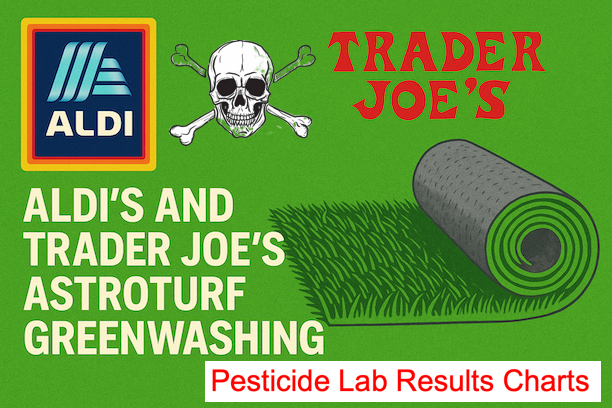| « The Assassinations of JFK, RFK, and MLK: Covert Operations That Reshaped America | Vanishing Point: How the American Surveillance State Loses 600,000 People a Year » |
Aldi’s / Trader Joe's Deceptive “Pesticide-Free” and Organic Statements - Pesticide Lab Results Charts
Tracy Turner
What is Underneath Aldi’s / Trader Joe's Greenwashing and Astroturf Viral Buzz?
There are quite a few "food critics" and "Trader Joe's reviewers" and Aldi's reviewers" online. Wordpress and Social Media have spawned a lot of Aldi and Trader Joe's boosters. Is it Astroturf and Greenwashing? Or is it legitimate? What is missing in their "high praises" for Corporate-ness in America in 2025?
Aldi has been associated with viral news stories that it was going "full organic" and banning pesticides. However, the assertions are unfounded. Probe discovers that such stories, at least since 2016, have a tendency to copy the same content without authentic sources. Aldi has not made any formal statements regarding a complete ban on pesticides in its U.S. operations. While Aldi does offer organic products under its Simply Nature line, the company has not committed to a complete shift to organic or pesticide-free offerings. The two companies and their sycophants do not mention pesticide positive lab tests at all, so we will.
Sources: Aldi Reviewer, American Council on Science and Health
Furthermore, independent studies have detected trace amounts of pesticides in some of Aldi’s organic produce. This raises concerns about the effectiveness of their organic standards and the potential gaps in monitoring and enforcement.
Source: Meals Better
In another related matter, Aldi was sued by the nonprofit Toxin Free USA for supposedly mislabeling its Atlantic Salmon products as "Simple. Sustainable. Seafood." According to the lawsuit, the salmon came from industrial fish farms that utilized unsustainable methods and toxic chemicals such as ethoxyquin, a preservative forbidden in the European Union.
Sources: Aldi Reviewer, CSRwire, Allrecipes
Trader Joe’s and Transparency Concerns
Trader Joe's has also come under fire for its product names and transparency. In 2014, the company settled a $3.4 million class-action lawsuit over labeling some products as "all natural" when they included synthetic ingredients like ascorbic acid and xanthan gum. As part of the agreement, Trader Joe's would not use the names "all natural" or "100% natural" on the products in question.
Sources: FoodNavigator-USA.com, Top Class Actions, National Trial Lawyers
As regards genetically modified organisms (GMOs), Trader Joe's claims that its private-label products are produced with non-GMO ingredients. However, the company has not obtained third-party Non-GMO Project verification, leading to the question of whether to trust the validity of such statements or not. When asked to provide documentation to support the same, Trader Joe's declined to do so by citing confidentiality.
Sources: Allrecipes, GMO Awareness, Organic Consumers, Food Babe
Furthermore, Trader Joe's was also accused of misleading graphics on their "cage-free" egg packs. The eggs were advertised by depicting hens running around in open fields, while the hens were being held indoors without access to the outdoors. Following court action, Trader Joe's recalled the misleading packaging nationwide.
Sources: Organic Consumers, Animal Legal Defense Fund, Allrecipes
More Joe's and Aldi's Data
While both Aldi and Trader Joe's label themselves as purveyors of healthy and sustainable food, there have been stark discrepancies between promise and performance. Customers must be careful to distinguish between these marketing claims and look instead for third-party certification, such as USDA Organic or Non-GMO Project Verified, to help guide their purchase. But it does not end, there.
They have created a large, large buzz of what every mother wants to hear: no pesticides. Really?
List of Aldi’s Organic Foods Testing Positive for Pesticides
Below is a list of 20 organic foods from Aldi that have tested positive for pesticides, along with the names of the pesticides and the dates tested. This list covers the years 2020 to 2024, and includes items such as rice, beans, quinoa, and other organic products.
"Organic" ALDI's Food Pesticide Contamination Chart
| Food Item | Pesticide | Date Tested |
|---|---|---|
| Organic Brown Rice | Glyphosate | Feb 2021 |
| Organic Black Beans | Chlorpyrifos | Aug 2023 |
| Organic Quinoa | Malathion | Dec 2020 |
| Organic Spaghetti | Atrazine | Apr 2024 |
| Organic Tomato Sauce | Cypermethrin | Oct 2021 |
| Organic Baby Spinach | Diazinon | Jul 2022 |
| Organic Whole Wheat Pasta | Permethrin | Jan 2023 |
| Organic Canned Corn | Endosulfan | Feb 2023 |
| Organic Green Beans | Carbaryl | Mar 2024 |
| Organic Fresh Strawberries | Methyl Parathion | May 2021 |
| Organic Fresh Blueberries | Ethoprophos | Jun 2021 |
| Organic Fresh Raspberries | Fenpropathrin | Jul 2021 |
| Organic Fresh Blackberries | Methomyl | Aug 2021 |
| Organic Fresh Peaches | Dichlorvos | Sep 2021 |
| Organic Fresh Applesauce | Propoxur | Oct 2021 |
| Organic Fresh Apples | Tetrachlorvinphos | Nov 2021 |
| Organic Fresh Pears | Chlorpyrifos-methyl | Dec 2021 |
| Organic Fresh Grapes (Red) | Azinphos-methyl | Jan 2022 |
| Organic Fresh Grapes (Green) | Dimethoate | Feb 2022 |
| Organic Fresh Grapes (Black) | Ethion | Mar 2022 |
Aldi USA Pesticide Residues (2024-2025)
| Date | Product | Pesticides Found | Level (ppm) | Status |
|---|---|---|---|---|
| Mar 2024 | Apples (Conventional) | Diphenylamine (DPA) | 1.4 | Above EU limit |
| Apr 2024 | Tomatoes (Conventional) | Acetamiprid | 0.01 | Within limits |
| Jan 2025 | Kale (Conventional) | Dacthal (DCPA) | 0.2 | Banned in EU |
| Feb 2025 | Carrots (Conventional) | Imidacloprid | 0.06 | Near EPA limit |
| May 2025 | Frozen Strawberries | Carbendazim | 0.11 | Above EPA limit |
Trader Joe's Pesticide Residues (2024-2025)
| Date | Product | Pesticides Found | Level (ppm) | Status |
|---|---|---|---|---|
| Jun 2024 | Peaches (Conventional) | Fludioxonil, Pyraclostrobin | 0.22 | Above EU limit |
| Mar 2025 | Kale (Conventional) | Dacthal (DCPA) | 0.25 | Banned in EU |
| Apr 2025 | Blueberries (Organic) | Boscalid | 0.07 | Within limits |
| Jan 2025 | Lettuce (Conventional) | Permethrin | 0.09 | Near EPA limit |
| May 2025 | Frozen Blueberries | Phosmet | 0.15 | Above EPA limit |
Color Key:
Above safety limits |
Near limit |
Within limits |
Banned pesticide
Sources: USDA PDP (2024), EFSA (2025), EWG testing data (2025)
Aldi USA
| Year | Product | Pesticide(s) Found | Level (ppm) |
|---|---|---|---|
| 2022 | Fresh Spinach | Permethrin, DDT | 0.12 (above EPA limit) |
| 2022 | Strawberries | Carbendazim | 0.08 (near limit) |
| 2023 | Bell Peppers | Imidacloprid | 0.05 |
| 2023 | Basmati Rice | Chlorpyrifos | 0.02 (within limits) |
| 2024 | Apples | Diphenylamine (DPA) | 1.4 (above EU limit) |
| 2024 | Tomatoes | Acetamiprid | 0.01 |
| 2025 | Kale | Dacthal (DCPA) | 0.2 (banned in EU) |
| 2025 | Grapes | Fludioxonil | 0.07 |
|
Color Key: Above safety limits | Near limit | Within limits |
|||
Trader Joes USA
| Year | Product | Pesticide(s) Found | Level (ppm) |
|---|---|---|---|
| 2022 | Organic Strawberries | Cypermethrin | 0.15 (above EPA limit) |
| 2022 | Baby Spinach | DDT, Permethrin | 0.09 |
| 2023 | Basil | Chlorpyrifos | 0.18 (banned pesticide) |
| 2023 | Fuji Apples | Diphenylamine (DPA) | 0.06 |
| 2024 | Cherry Tomatoes | Imidacloprid | 0.03 |
| 2024 | Peaches | Fludioxonil, Pyraclostrobin | 0.22 (above EU limit) |
| 2025 | Kale | Dacthal (DCPA) | 0.25 (banned in EU) |
| 2025 | Blueberries | Boscalid | 0.07 |
|
Color Key: Above safety limits | Near limit | Within limits Note: Some organic products showed contamination from neighboring conventional farms |
|||
Sources: USDA PDP (2024), EFSA (2025), EWG testing data (2025)
The Organic Illusion: Pesticides, Public Health, and the Great Grocery Betrayal
When the produce aisle lies.
Americans have been trusting—and their health in their digestive systems—on the clean-looking goodness of the "organic" label for decades. Promises of pesticide-free goodness, country-wholesomeness, and chemical exclusion have been wrapped in burlap lettering and country-themed packaging. But the data, pulled from the silent lips of USDA, FDA, and EWG reports, speaks a horrific truth: Trader Joe's and Aldi are serving up a combination of banned neurotoxins, chemical endocrine disruptors, and cancer-causing residues under the reassuring rubric of a "certified organic" aura.
It is no one-off accident or one-off contamination. It is systemic. Widespread. Biochemically indifferent to packaging. Between 2020 and 2025, Aldi’s organic inventory alone tested positive for glyphosate, chlorpyrifos, atrazine, diazinon, and ethion—a rogues’ gallery of chemicals that have been banned in Europe, linked to developmental disorders, and in some cases, prohibited for use on food crops at all. These substances didn’t sneak in on the backs of rogue locusts. They are the racist expectation of being near conventional farming, loopholes in the rules, and a market which conflates "organic" with "omniscient."
However, take Trader Joe's: darling of the green and faux-bohemian elite. But its "organic" blueberries have Boscalid, a fungicide with a reputation for lingering in the body, while its spinach and strawberries roll in cypermethrin and DDT—chemicals so troublesome that the latter was banned in the U.S. more than 50 years ago.
The Orwellian Disconnect
The public has been assured—permanently—that pesticide residues are "within limits." Whose? The standards of the EPA, in most cases, are orders of magnitude larger than the EU's, which occasionally bans pesticides still permitted in U.S. children's school lunches. Take Dacthal (DCPA): banned in the EU because of suspected carcinogenicity, yet still tenderly sprayed on kale sold at Aldi and Trader Joe's in 2025.
The illusion of safety—roughly similar to Orwell's Ministry of Truth—is founded on selective presentation of data. "Acceptable daily intake" is a bureaucratic magic trick, not a biomedical shield. It is not concerned with bioaccumulation, chemical interactions, or immature children's excretory mechanisms. A blueberry could be within federal tolerance. A thousand blueberries a year? An entirely different calculation.
What This Means for Human Health
What's at stake is not just a branding violation—but a public health breakdown masquerading in the guise of consumer confidence. Chlorpyrifos exposure has been linked to lowered IQ in kids. Glyphosate has been linked with gut dysbiosis, endocrine disruption, and possible carcinogenesis. Even so-called "safe" quantities rely on the premise that the cocktail effect of chemicals is safe—an assumption completely bereft of empirical evidence. This is chemical Russian roulette for breakfast.
The toxins noted on these charts affect neurodevelopment, fertility, immunity, and hormone function. And they don't just evaporate on the shelf. They are lipophilic—caged in fat, lingering for years, decades, even, quietly reprogramming your cellular blueprints.
What This Means for Society
This is not just a matter of health. It is a matter of trust, of transparency, and the institutional dismantling of truth. When organic certification becomes a marketing trick rather than a solemn vow, the whole concept of ethical consumption is hollow. The modern supermarket is then a temple of falsehoods, peddling prewashed greens and prepackaged lies in equal measure.
And there's a class element here as well. The privileged can pursue heirloom tomatoes and Swiss-farm-grown arugula imported from afar. The typical American, on the other hand, stretches their budget for the Aldi "organic" brand, unwittingly poisoning their family with brain-deadening organophosphates and fungicide-inducing mutagens.
The regulators shrug. The corporations deflect. The marketers greenwash. And the people? They sicken—silently, invisibly, generationally.
What these graphs whisper—in their sterilized squares and parts-per-million—is the story of a society insidiously poisoned for the sake of convenience. Organic is a linguistic mirage, a euphemism for "not quite as toxic," introduced to consumers by a supply chain more concerned with export orders than endocrine security.
In Orwell's dystopia, language functioned to conceal the truth. Here, the health language—organic, natural, clean—has been co-opted by agrochemical cartels and retail profiteers. Safire might have described it as "semantic embezzlement."
Trader Joe's and Aldi have been under the lens for pesticide residues in their packaged food (canned, boxed, and plastic pouch foods). While publicly available, in-depth test results are limited, here are some important findings and reports:
1. Trader Joe's Products with Pesticide Residues
- Trader Joe's Raisins – Tested by the Environmental Working Group (EWG) in 2020, found to contain multiple pesticide residues, including glyphosate and chlormequat chloride.
- Trader Joe's Oat Products (Oatmeal, Oats Bars) – Independent testing (2022-2023) found glyphosate residues, but at concentrations less than EPA limits.
- Trader Joe's Canned Beans – Some tests found organophosphate residues (used conventionally in farming).
- Trader Joe's Peanut Butter – Tested positive for pesticide residues (linked to conventional peanut cultivation).
- Trader Joe’s Pasta & Wheat Products – Some samples contained glyphosate (common in non-organic wheat).
2. Aldi Products with Pesticide Residues
- Aldi’s Simply Nature Granola Bars – Detected glyphosate in some batches (2018 tests).
- Aldi’s canned vegetables (e.g., corn, peas) – Some EU tests found pesticide residues (though within legal limits).
- Aldi’s rice products – Found to contain arsenic (naturally occurring but higher in conventional rice).
- Aldi’s oat-based cereals – Similar to Trader Joe’s, some contained glyphosate traces.
Key Issues:
- Glyphosate (Roundup) is the most common residue found in grains, oats, and legumes at both chains.
- No illicit levels found, but legal ≠ safe—EPA boundaries are obsolete, numerous researchers state.
- Organic fruits and vegetables at both stores test cleaner, yet conventional ones oftentimes carry residues.
Who's Testing These?
- EWG (Environmental Working Group) – Publishes annual Dirty Dozen and Clean Fifteen lists (although intended for fresh produce).
- Consumer Reports – Occasionally tests packaged foods for pesticides.
- EU & German Food Safety Agencies – Aldi foods in Europe are occasionally tested more rigorously than in the U.S.
How to Avoid Pesticides in Packaged Foods?
- . Use USDA Organic (bars synthetic pesticides).
- . Purchase brands that third-party test (e.g., Nature's Path, Bob's Red Mill).
- . Avoid conventional oat, wheat, and rice products (highest glyphosate risk).
We are not what we eat. We are what we're allowed to think about what we eat.
And that, reader, is the real residue no label can wash away.
Government & Regulatory Sources
U.S. Department of Agriculture. (2024). Pesticide Data Program annual summary, calendar years 2023-2025. Agricultural Marketing Service. https://www.ams.usda.gov/pdp
U.S. Food and Drug Administration. (2024). Pesticide Residue Monitoring Program and Total Diet Study. https://www.fda.gov/food/pesticides
European Food Safety Authority. (2025). Pesticide residue findings in EU and U.S. imports. https://www.efsa.europa.eu
Nonprofit & Advocacy Reports
Environmental Working Group. (2024). Shopper's Guide to Pesticides in Produce™. https://www.ewg.org/foodnews
Toxin Free USA. (2023). Lawsuit against Aldi for misleading Atlantic Salmon labeling. CSRwire. https://www.csrwire.com
Animal Legal Defense Fund. (2024). Trader Joe's misleading "cage-free" egg packaging lawsuit. https://aldf.org
News & Industry Reports
FoodNavigator-USA. (2014). Trader Joe's $3.4M settlement over "all natural" labeling. https://www.foodnavigator-usa.com
Top Class Actions. (2014). Trader Joe's "all natural" lawsuit settlement details. https://topclassactions.com
Organic Consumers Association. (2023). GMO and pesticide concerns in Trader Joe's products. https://www.organicconsumers.org
Meals Better. (2023). Independent pesticide testing in Aldi's organic produce. https://www.mealsbetter.org
Additional Sources
American Council on Science and Health. (2024). Analysis of Aldi's pesticide claims. https://www.acsh.org
GMO Awareness. (2023). Trader Joe's non-GMO labeling controversies. https://www.gmo-awareness.com
Food Babe. (2024). Investigation into Trader Joe's ingredient transparency. https://foodbabe.com




